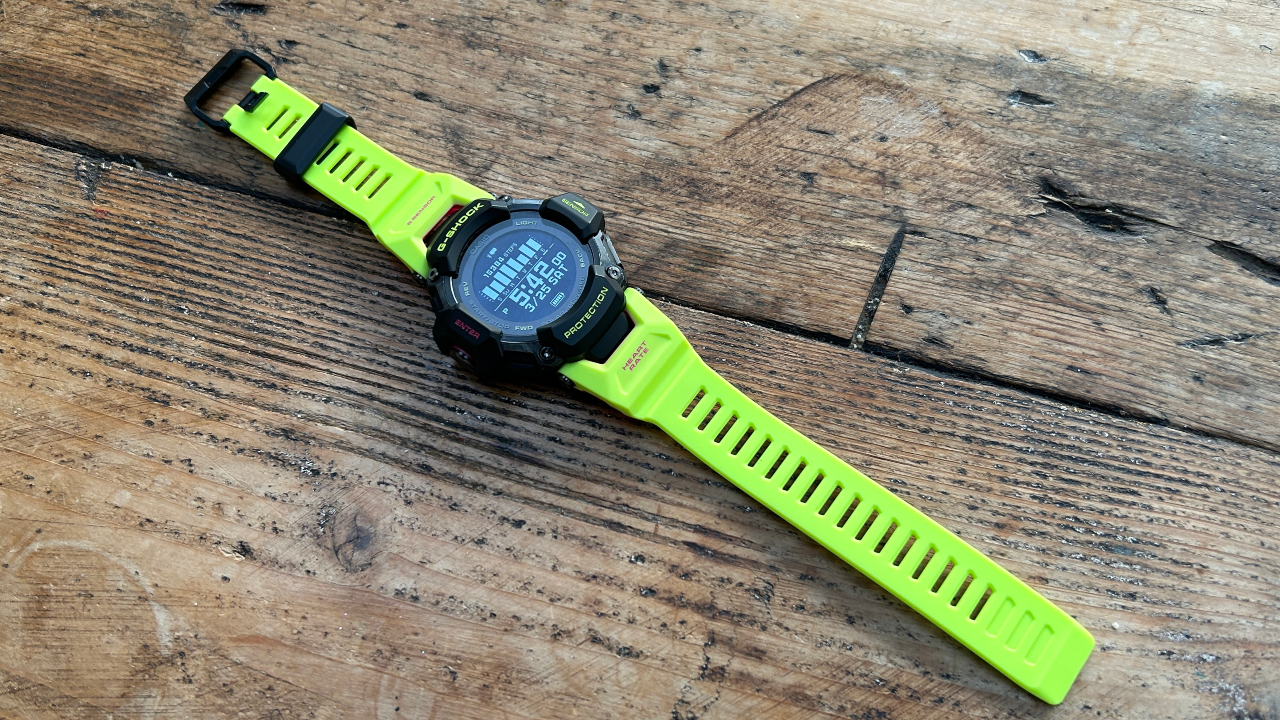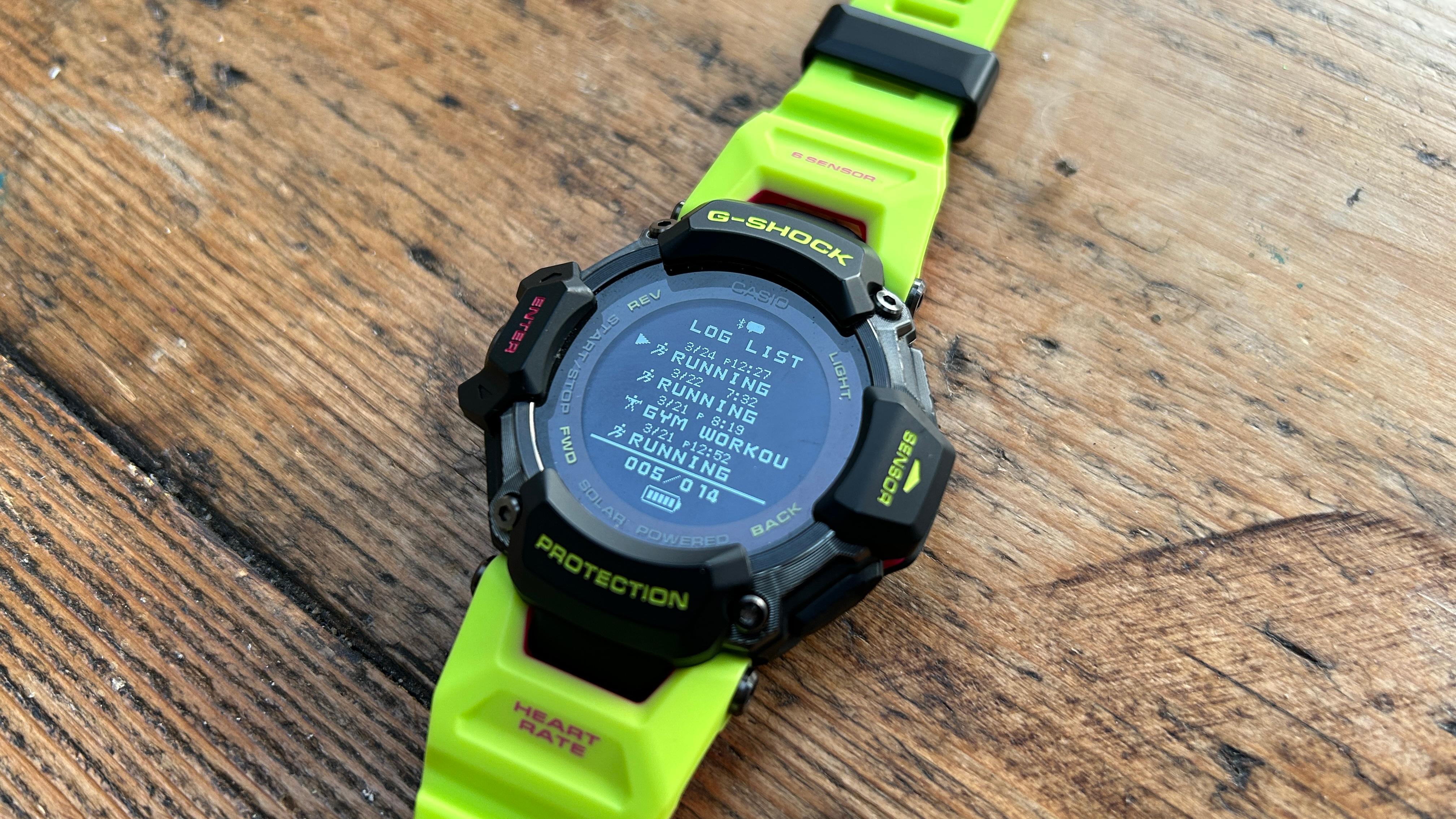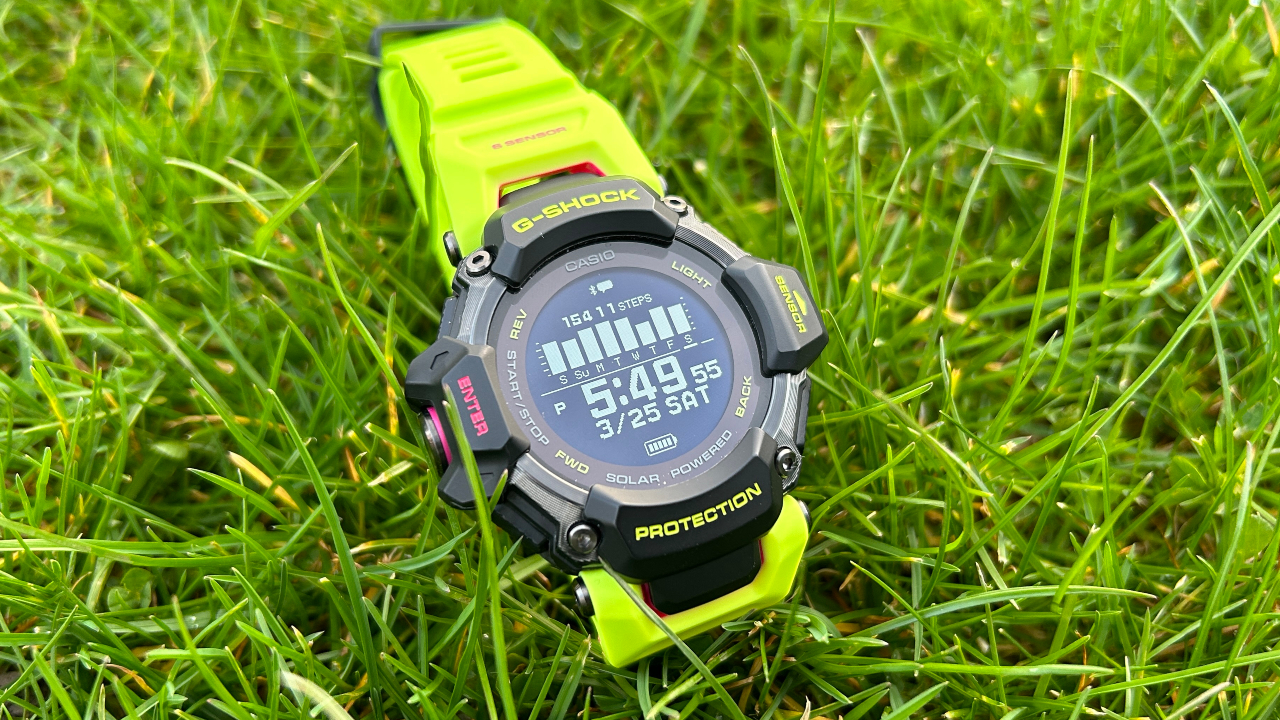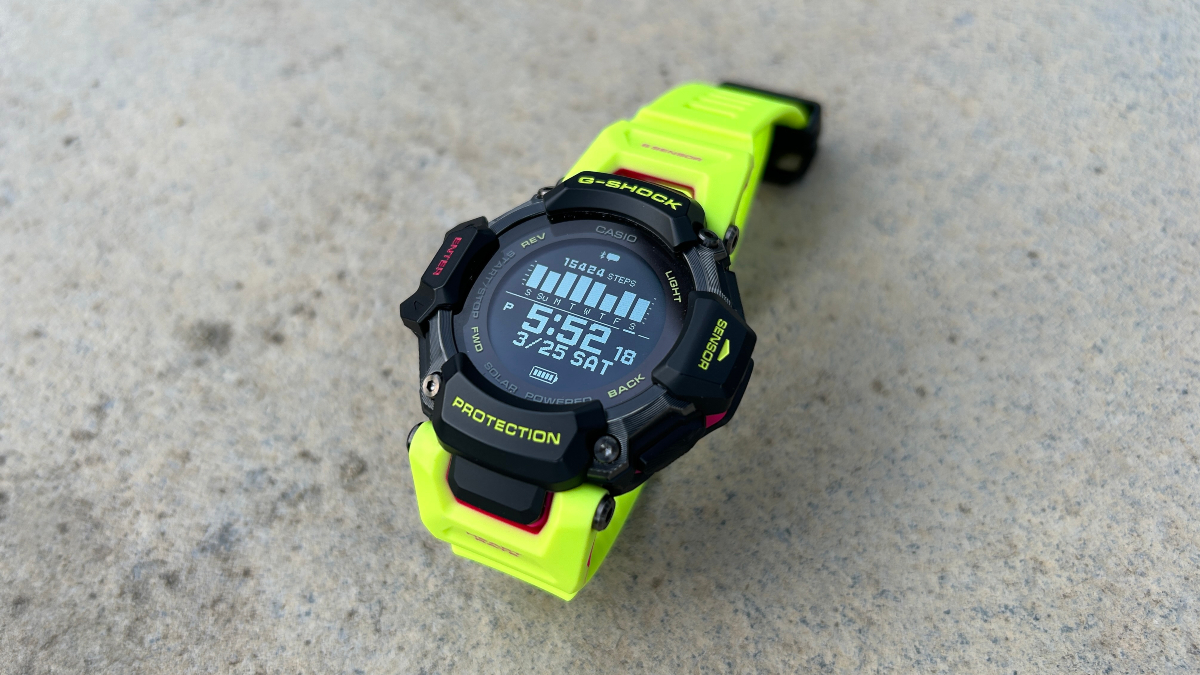Our Verdict
The Casio G-Shock GBD-H2000 is a significant improvement on the Casio G-Shock GBD-H1000, but is still likely to appeal to those who are G-Shock fans already. It’s a solid sports watch with a distinctive design, though it lacks the features available on devices from rivals like Garmin, Polar and Coros.
For
- Lighter and smaller than GBD-H1000
- Polar’s sleep tracking
- Accurate GPS
- Long battery life
Against
- Poor HR accuracy
- Annoying interface
- No triathlon mode
- No navigation features
You can trust Coach
While it still doesn’t reach the standards of the best sports watches, the G-Shock GBD-H2000 is a big step in the right direction for Casio. It is lighter and more comfortable than its predecessor, the GBD-H1000, has more sports modes and also introduces features from Polar, such as sleep tracking and basic training analysis.
However, it is expensive considering the features you get and non-Casio fans will find there are better watches for less money. If you are enamored of the G-Shock style and rugged design, though, then you now have a decent sports watch to invest in.
Casio G-Shock GBD-H2000 Review: Price And Availability
The Casio G-Shock GBD-H2000 launched in March 2023 and costs $399 in the US and £379 in the UK.
Design
Coach’s reviewer noted how chunky and heavy the G-Shock GBD-H1000 was, so I was pleased to see that Casio has made the GBD-H2000 lighter and smaller. It’s still a large watch that stands out a long way from the wrist, but now weighs 63g (down from 101g) and has a 59.5mm (H) x 52.6mm (W) case—the GBD-H1000’s was 63mm (H) x 55mm (W). It remains rugged and shock-resistant and is waterproof to 200m, and the case and strap use biomass plastics made from renewable sources. The watch comes in four colors.
The screen is a clear monochrome memory-in-pixel display, which is surrounded by solar panels to increase battery life. It will last up to two months in watch mode, and if you just want it to show the time a power-saving feature allows the GBD-H2000 to last years with a bit of sun.

Inside, the GBD-H2000 is laden with sensors, including a barometer, altimeter, accelerometer and pulse oximeter to measure blood oxygen saturation. It has an optical heart rate sensor and buil-tin GPS. You can’t connect external sensors to the watch, however, which is a common and useful feature in many sports watches.
The design isn’t to my taste and is so chunky that, at times, I found it uncomfortable. However, the G-Shock style is popular and Casio has done a good job of making the watch lighter while packing in the sensors needed for sports tracking.
Sign up for workout ideas, training advice, reviews of the latest gear and more.
How I Tested This Watch
I’ve had the Casio G-Shock GBD-H2000 for two weeks and worn it throughout that time to track my workouts, as well as daily activity and sleep. I’ve tracked 12 runs with the watch, along with seven gym workouts, which actually covers yoga, strength and indoor cardio sessions. I’ve also tested most of the best sports watches on the market.
Sports Tracking

A fault of the Casio G-Shock GBD-H1000 was that it didn’t track anything but running. That’s no longer the case with the GBD-H2000, which has eight sports modes: running, trail-running, hiking, biking, pool swimming, open-water swimming, a generic interval timer and gym-workout mode to cover everything else. The most notable omission, however, is a triathlon mode that allows you to record multisport activities in one session, including transitions.
You can customize data screens for each sport, with up to three stats shown on a screen. The range of stats isn’t as wide as with other watches, and having only three stats is less than you get elsewhere, but it suffices.
After tracking your workout you can view a breakdown of your stats on the watch, with more detail in the Casio Watches app. This is where the Polar features on the watch come in, with running index, cardio load and energy used all shown.
Running index is only for runs and provides your VO2 max and a rating of how you compare with others. Cardio load is for all workouts and uses your heart rate to measure the training load of your session, which then contributes to your cardio status, which rates if your training is productive or if you’re over- or under-doing it.

Energy used is part of Polar’s Fuelwise feature and shows if you mainly burned carbs or fat as your source of fuel during your workout. This lines up with the heart rate zone you are in during a workout, with carbs the main source of fuel in higher zones.
The level of detail is more than enough for most people, if less than you get from dedicated sports watches. The training analysis from Polar’s cardio status is basic, just showing a couple of stats. With a Polar watch you get more detail, while the same is true of the training analysis from Garmin and Coros watches at the same price.
The sports tracking experience with the GBD-H2000 is the best from a Casio watch yet, but still falls behind what’s available elsewhere. You also can’t export workouts to Strava and other apps from the Casio Watches app, and there are no navigation features, such as breadcrumb trails or a back-to-start feature, which are available on many sports watches in its price range.
GPS And HR Accuracy
I enabled the most accurate GPS tracking on the watch throughout my testing and the results were impressive. For the most part, the GBD-H2000 tracked all my outdoor activities reliably, with GPS tracks that didn’t show any obvious errors and consistent distance and pacing stats. It wasn’t as spot on as the dual-band tracking of the Garmin Forerunner 265 I was testing at the same time, but it was close enough with regards to pacing on most runs.
A problem I had with GPS was how long it sometimes took to lock on at the start of activities. This was always longer than the Garmin watch on my other wrist, and sometimes the Casio took two or three minutes to lock on. That doesn’t sound much, but it’s a long time considering every other GPS watch I’ve used lately locks on within 15 seconds. If I was impatient and started the run before the GPS locked on, the tracking was terrible for the first mile, so you do have to stick it out and get the GPS fixed before you go.
I can’t say anything so positive about the heart rate tracking, which was wrong as often as it was right during workouts, when compared with the readings of a chest strap. You can’t pair external sensors to the Casio either (as far as I can tell), so you’re stuck with the optical wrist monitor, which underperformed even by the fairly low expectations I have for them.
Activity And Sleep Tracking

The Casio G-Shock GBD-H2000 tracks your steps, calories burned and active time, all of which you can see in the Life Log widget on the watch. You can set your step and calorie targets, and show your step count on a couple of the available watch faces. The step count largely tallied up with what was measured by a Garmin on my other wrist.
Polar takes care of the sleep tracking on the watch, and while it’s not as detailed as the tracking you receive from a Polar watch, you get a good breakdown of your night’s rest in the app each morning. The watch also has Polar’s Night Recharge function, which takes into account factors like your heart rate variability and sleep time to highlight how well your nervous system has recovered overnight.
It’s hard to be definitive with regard to the accuracy of sleep tracking, but I didn’t notice any glaring errors with the Casio. What I can say is that I did find the watch uncomfortable to wear in bed.
Battery Life
It’s a chunky watch with a basic display and solar panels, so I was expecting to be impressed by the G-Shock GBD-H2000’s battery life. By and large I was. I only had to charge the watch once during the two weeks I tested it and finished that period with around 30-40% battery remaining.
This is with heavy use as well. I used the most accurate GPS mode, which is listed as giving 14 hours of tracking, and tracked outdoor runs almost every day, as well as having notifications enabled on the watch and tracking my heart rate at all times.

You can extend the GPS tracking to 19 hours if you’re happy to accept less accurate distance and pace readings, but that’s still a low number for a sports watch. Many sports watches will offer more than 20 hours of GPS tracking, even much smaller ones that have less battery life than the Casio G-Shock GBD-H2000.
Where the Casio’s battery life shines is outside of workouts, since it uses very little battery when you’re not firing up the GPS. Enabling the always-on heart rate and using the watch to track your sleep is the biggest drain on battery, and you’ll need to turn those features off to hit the months of battery life listed—but it does still last a long time with everything turned on.
User Interface And App
With its monochrome screen and slightly unresponsive buttons, the G-Shock GBD-H2000 doesn’t offer a slick user experience. The menus are laid out simply, but when navigating the watch there are lags, and sometimes button presses are missed. The app is basic and not the most intuitive to use, and updating the software on the watch was a nightmare, taking me five or six attempts.
The user experience is an area where the GBD-H2000 isn’t up to the standards of other sports watches at its price, which are more intuitive and enjoyable to interact with, especially if they have brighter, color screens.
Is The Casio G-Shock GBD-H2000 Worth It?
Despite being a major improvement on what Casio has offered before, the GBD-H2000 is only likely to appeal to committed G-Shock fans who want a sports watch. It lags behind sports watches from rivals on almost every front, and while there’s a charm to the GBD-H2000’s simplistic approach, it’s less charming at $399/£379 when the Garmin Instinct 2 Solar, Garmin Forerunner 255, and Polar Pacer Pro are all cheaper and more complete multi-sport watches.
The design is clearly a big part of the appeal here, but I found it large and annoying to wear at times, and the screen is not as vibrant as options available elsewhere.
If you want one of the best sports watches, I’d look elsewhere. If you want a G-Shock that’s also an OK sports watch, here it is.

Nick Harris-Fry is a journalist who has been covering health and fitness since 2015. Nick is an avid runner, covering 70-110km a week, which gives him ample opportunity to test a wide range of running shoes and running gear. He is also the chief tester for fitness trackers and running watches, treadmills and exercise bikes, and workout headphones.

